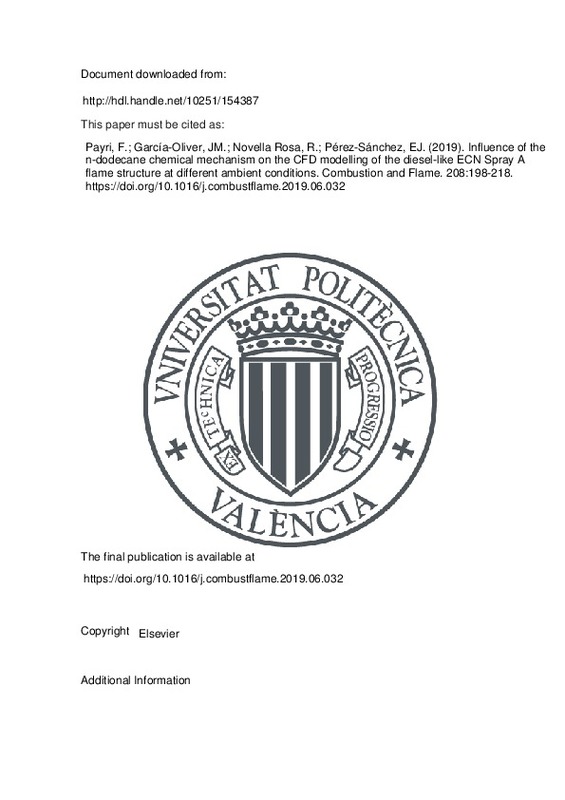JavaScript is disabled for your browser. Some features of this site may not work without it.
Buscar en RiuNet
Listar
Mi cuenta
Estadísticas
Ayuda RiuNet
Admin. UPV
Influence of the n-dodecane chemical mechanism on the CFD modelling of the diesel-like ECN Spray A flame structure at different ambient conditions
Mostrar el registro sencillo del ítem
Ficheros en el ítem
| dc.contributor.author | Payri, F.
|
es_ES |
| dc.contributor.author | García-Oliver, José M
|
es_ES |
| dc.contributor.author | Novella Rosa, Ricardo
|
es_ES |
| dc.contributor.author | Pérez-Sánchez, Eduardo Javier
|
es_ES |
| dc.date.accessioned | 2020-11-07T04:32:34Z | |
| dc.date.available | 2020-11-07T04:32:34Z | |
| dc.date.issued | 2019-10 | es_ES |
| dc.identifier.issn | 0010-2180 | es_ES |
| dc.identifier.uri | http://hdl.handle.net/10251/154387 | |
| dc.description.abstract | [EN] Encouraged by the diversity of n-dodecane chemical mechanisms currently available, this investigation focuses on analysing the impact of using different fuel oxidation schemes on the diesel-like Engine Combustion Network (ECN) Spray A flame structure, simulated by means of an Unsteady Flamelet Progress Variable (UFPV) combustion model. The present research discusses systematically the characteristics of four n-dodecane chemical mechanisms in perfectly stirred reactors and counterflow laminar diffusion flames (flamelets) before the final evaluation in turbulent reacting sprays in order to describe the effects of adding different physical levels of complexity to the ignition of the mixtures. In addition, this analysis is complemented with the description of the effect of the boundary conditions on the flame structure. Results evidence the extreme importance of the low temperature chemistry including the period for which the cool flame extends. The different prediction of this stage between mechanisms leads to noticeable different laminar flame structures which in turn produce substantially distinct turbulent flames, especially in the vicinity of the lift-off length (LOL) in terms of reactivity and positioning in the Z-T map. Finally, simulations confirm the strong effect of the boundary conditions, especially for the ambient temperature, on the ignitable mixtures which directly impacts on the soot precursors formation. (C) 2019 The Combustion Institute. Published by Elsevier Inc. All rights reserved. | es_ES |
| dc.description.sponsorship | Authors acknowledge that this work was possible thanks to the Ayuda para la Formacion de Profesorado Universitario (FPU 14/03278) belonging to the Subprogramas de Formacion y de Movilidad from the Ministerio de Educacion, Cultura y Deporte from Spain. This work was partially funded by the Government of Spain through CHEST Project (TRA2017-89139-C2-1-R). | es_ES |
| dc.language | Inglés | es_ES |
| dc.publisher | Elsevier | es_ES |
| dc.relation.ispartof | Combustion and Flame | es_ES |
| dc.rights | Reconocimiento - No comercial - Sin obra derivada (by-nc-nd) | es_ES |
| dc.subject | Combustion modelling | es_ES |
| dc.subject | Spray A | es_ES |
| dc.subject | Flamelet concept | es_ES |
| dc.subject | Auto-ignition | es_ES |
| dc.subject | Chemical mechanism | es_ES |
| dc.subject.classification | MAQUINAS Y MOTORES TERMICOS | es_ES |
| dc.title | Influence of the n-dodecane chemical mechanism on the CFD modelling of the diesel-like ECN Spray A flame structure at different ambient conditions | es_ES |
| dc.type | Artículo | es_ES |
| dc.identifier.doi | 10.1016/j.combustflame.2019.06.032 | es_ES |
| dc.relation.projectID | info:eu-repo/grantAgreement/AEI/Plan Estatal de Investigación Científica y Técnica y de Innovación 2013-2016/TRA2017-89139-C2-1-R/ES/DESARROLLO DE MODELOS DE COMBUSTION Y EMISIONES HPC PARA EL ANALISIS DE PLANTAS PROPULSIVAS DE TRANSPORTE SOSTENIBLES/ | es_ES |
| dc.relation.projectID | info:eu-repo/grantAgreement/MECD//FPU14%2F03278/ES/FPU14%2F03278/ | es_ES |
| dc.rights.accessRights | Abierto | es_ES |
| dc.contributor.affiliation | Universitat Politècnica de València. Departamento de Máquinas y Motores Térmicos - Departament de Màquines i Motors Tèrmics | es_ES |
| dc.description.bibliographicCitation | Payri, F.; García-Oliver, JM.; Novella Rosa, R.; Pérez-Sánchez, EJ. (2019). Influence of the n-dodecane chemical mechanism on the CFD modelling of the diesel-like ECN Spray A flame structure at different ambient conditions. Combustion and Flame. 208:198-218. https://doi.org/10.1016/j.combustflame.2019.06.032 | es_ES |
| dc.description.accrualMethod | S | es_ES |
| dc.relation.publisherversion | https://doi.org/10.1016/j.combustflame.2019.06.032 | es_ES |
| dc.description.upvformatpinicio | 198 | es_ES |
| dc.description.upvformatpfin | 218 | es_ES |
| dc.type.version | info:eu-repo/semantics/publishedVersion | es_ES |
| dc.description.volume | 208 | es_ES |
| dc.relation.pasarela | S\392691 | es_ES |
| dc.contributor.funder | Ministerio de Educación, Cultura y Deporte | es_ES |
| dc.contributor.funder | Agencia Estatal de Investigación | es_ES |







![[Cerrado]](/themes/UPV/images/candado.png)

